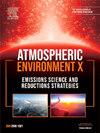Emission characteristics of railway tread brakes
IF 3.8
Q2 ENVIRONMENTAL SCIENCES
引用次数: 0
Abstract
Braking of freight cars in rail transport mostly happens mechanically, as tread brakes are the only braking system. For this reason, non-exhaust particle (NEP) emissions can be expected. In order to quantify the emissions of such brakes, an extensive series of tests was conducted on a rail brake test bench at Graz University of Technology. The quantification of NEP emissions was done for grey cast iron as well as composite blocks and included the observation of emitted particle mass, particle size distribution, analysis of particle composition as well as the monitoring of gaseous substances. The test results indicated that grey cast iron brake shoes represent the highest emitter. PM10 emission factors for brake events were derived in the range of 2.65–28.66 g/km (km refers to braking distance). Iron and manganese were present in most of the tests. Barium and zinc could only be identified in tests with type K brake shoes.
求助全文
约1分钟内获得全文
求助全文
来源期刊

Atmospheric Environment: X
Environmental Science-Environmental Science (all)
CiteScore
8.00
自引率
0.00%
发文量
47
审稿时长
12 weeks
 求助内容:
求助内容: 应助结果提醒方式:
应助结果提醒方式:


